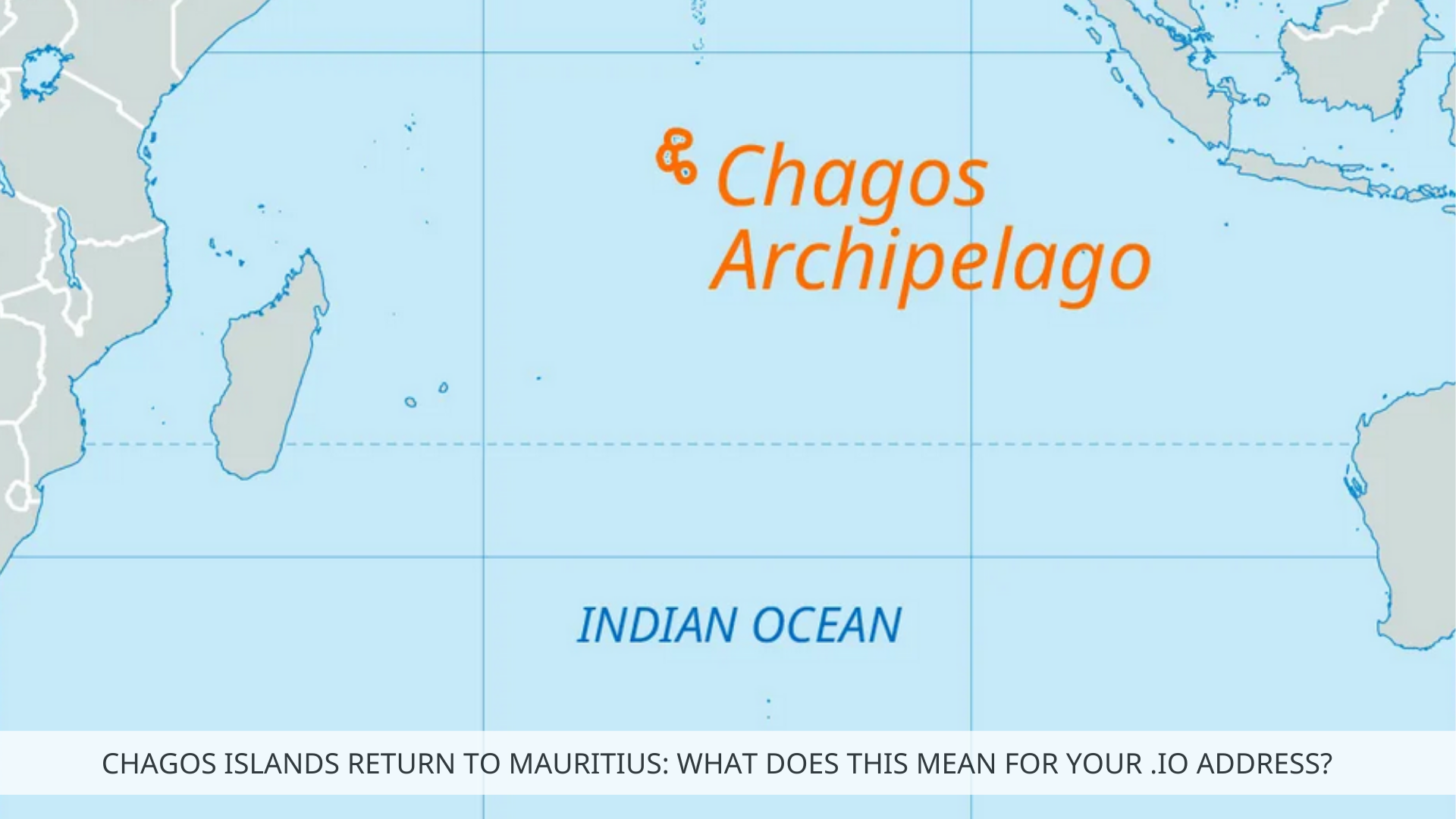Despite rumors: .IO domain names aren't going away
Great Britain is returning its overseas territory Chagos Islands to Mauritius. Will this affect the .io tld domain?
On October 3, 2024, the United Kingdom announced that it’s giving up sovereignty over its oversea territory Chagos Islands, transferring them back to Mauritius. This might be side-news, something that has not caused your attention, yet. But in tech, this is big news because the .io domain is highly popular among tech companies. So, why does the territory change of a small island in the Indian Ocean might matter to you? Let’s find out!
As you might have guessed, the “.io” domain is assigned to the British Chagos Islands. When control changes hands, so does the fate of this tld domain.
The “.io” domain became popular among startups and developers as it’s associated with “input/output” in tech. Sites like Github.io and Google I/O helped boost its popularity.
But here’s the catch: “.io” is actually an internet country code top-level domain (ccTLD), meaning it’s tied to the now-defunct British Indian Ocean Territory.
When the handover is finalized, the ISO (International Organization for Standardization) will remove the “IO” country code from its database. The question is whether this will cause the Internet Assigned Numbers Authority (IANA), which manages domain names, to stop issuing new “.io” domains. It is also uncertain what will happen to existing “.io” domains.
What history teaches us
The risks of the .io domain going away and ceasing to exist are underscored by historical precedents where political changes affected country-specific top-level domains (ccTLDs). When the Soviet Union collapsed in 1991, the .su domain lingered despite the country’s dissolution. Though ICANN considered phasing it out, .su persisted and eventually became a haven for cybercrime and dubious activities because of its ambiguous legal status. While Russia was given the .ru domain, .su still exists, though its domain future remains uncertain.
A similar situation occurred with the breakup of Yugoslavia in the early 1990s. The country’s ccTLD, .yu, remained in use even as the nation disintegrated into several independent countries. Transitioning to new ccTLDs like .rs for Serbia and .hr for Croatia was chaotic, creating confusion over domain control. ICANN eventually retired the .yu domain in 2010 and the .yu domain went away just like that, forcing a migration that caused operational difficulties for many domain holders on this tld.
What is the .IO domain?
The question is whether the tld .io will share a similar fate. To make a clear judgment on this question, let’s first look at what the .io domain actually is: The .io domain is the assigned country code for the British Indian Ocean Territory but is widely used by tech companies and startups. Its short, memorable format and minimal restrictions make it ideal for branding. Consequently, .io has become a popular choice in the tech industry worldwide.
The examples of the .su and .yu domains demonstrate how geopolitical changes can lead to long-term complications for ccTLDs, including legal limbo, misuse, or the forced migration of domain holders. Now that the political status of the British Indian Ocean Territory changes, the .io tld could face similar challenges, it could even go away completely, potentially requiring domain owners to migrate or risk losing access to their domains.
However, the risk of the .io domains going away in the future is quite low. Let’s understand why!
Reasons for the .io domains to stay active
Here are the reasons why the .io domain is unlikely to go away, but will stay active:
-
.IO domain names are highly popular among tech startups, cryptocurrency platforms, and developers because their association with “input/output” creates a positive feeling among computing professionals, creating a strong market for the domain. Google I/O kicked off the popularity of .io domains, and it hasn’t ceased since.
-
The .io tld domain generates significant income through registrations and renewals. Companies have heavily invested in .io for branding and infrastructure, which creates financial incentives to maintain its availability.
-
Identity Digital (formerly Afilias), which manages the .io domain, profits from its widespread use. Shutting down the domain would result in a direct financial loss to the registry, making discontinuation unlikely.
-
Lastly: This is not the Soviet Union or Yugoslavia where the dissolution of these countries was even more chaotic than what happened to their domains. Even if governance of the British Indian Ocean Territory (BIOT) changes, the value of the territorial .io tld domain in the global digital economy ensures that stakeholders will likely negotiate to keep it running for financial reasons.
We at Tuta are quite certain that IANA (Internet Assigned Numbers Authority), the department within ICANN (Internet Corporation for Assigned Names and Numbers) that manages top level domains, will allow .io domain names to persist and make sure that this tld domain will NOT go away.
Should I switch from .io to a different domain?
Right now, switching to a new domain from .io is not necessary. Even if the .io domain were to cease in existence, IANA would announce that well in advance - most likely more than three years before this actually happening.
Domains, particularly top level domains, make up an important part of the internet. They have become similar to physical addresses - maybe even more so as people remember website links or store them in their browser, making it easy for them navigate the large and never-ending world wide web. A top level domain can’t just go away in a day. There must be a proper procedure in place so that companies, customers, and internet users alike can prepare for the change. Just like when you are moving houses, a lot of preparation is needed when websites - let alone entire domains - need to move.
That’s why the .io domain will not go away anytime soon.
However, if you want to be absolutely sure that nothing ever happens to your domain, and you want to keep using it in the future still, say in 30 years from now, we would recommend that you choose a popular domain that is going to be stable such as .com (generic TLD intended for commercial use) or .de (top level domain of Germany).
Generic top level domains like .com are not linked to a country or territory so that these are less likely to go away caused by geopolitical changes. Given the historical examples in this article, it’s also noteworthy to mention that the German TLD .de was introduced in 1986 - and despite political changes towards the end of the 80s which resulted in the reunion of Germany, nothing happened to the German .de domain; it’s still in use today.
So if you’re using a tuta.io email address, there’s nothing to worry about, and you can keep using this email address well into the next years - most likely for as long as you want to. However, if you want to be 100% certain that your email address stays available forever, you can easily upgrade your account to Revolutionary or Legend and add a tuta.com email address to your account.


